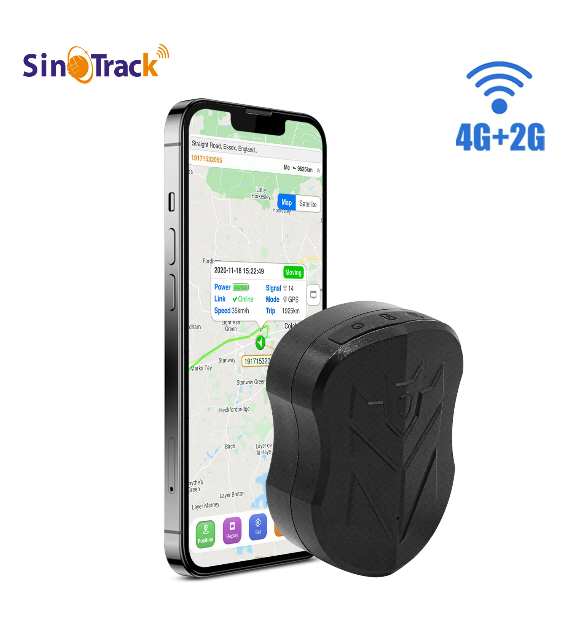Factors Affecting Wireless GPS Tracker Battery Life
Device Type and Usage Patterns
The type of wireless GPS tracker significantly impacts battery life due to varying power demands based on design and usage features. Devices like personal trackers for pets often have different energy needs compared to vehicle or logistics trackers. Additionally, usage patterns play a crucial role in determining battery longevity. Factors such as frequency of use and whether the device operates continuously or intermittently can heavily influence battery life. For instance, GPS trackers in logistics often require constant location reporting, consuming more power than those used intermittently, such as pet trackers which might only check in periodically.
Battery Capacity and Quality
Battery capacity, measured in milliampere-hours (mAh), is a critical determinant of how long a wireless GPS tracker can last between charges. Typically, higher capacity translates into extended battery life. Moreover, the quality of the battery used is essential. Premium lithium-ion batteries are known for their power retention and long-lasting performance compared to cheaper alternatives. According to research by battery manufacturers, using top-tier batteries can improve performance by up to 25% over standard ones, making them a preferred choice for those looking to maximize tracker longevity and reliability.
Tracking Frequency and Data Transmission
The frequency at which data is transmitted from a GPS tracker directly affects battery consumption. More frequent data transmissions mean the device wakes up more often, leading to an increased battery drain. For example, adjusting the frequency from sending data every minute to every hour can conserve battery and prolong its life. A recent study supports this adjustment, suggesting that optimizing the tracking frequency can extend battery life by as much as 30%. This insight is crucial for applications requiring long-term tracking without frequent recharges.
Environmental Impact on Power Drain
Environmental factors such as temperature, humidity, and exposure to elements impact GPS tracker battery performance. Extreme temperatures are particularly detrimental; cold conditions can degrade battery efficiency by up to 20%, leading to faster depletion. Furthermore, GPS signal strength in urban areas often results in higher power usage as devices work harder to establish locations, further draining the battery. Understanding these environmental impacts can help anticipate and mitigate potential power drain and enhance battery life through strategic use and storage.
Average Battery Life Expectations for Wireless GPS Trackers
Short-Term vs. Long-Term Tracking Devices
Short-term and long-term GPS trackers differ significantly in their battery life due to their distinct purposes and designs. Short-term GPS trackers typically possess smaller batteries that are designed to last from a few days up to several weeks based on usage intensity. Conversely, long-term tracking devices often come equipped with larger or more efficient batteries, sometimes even utilizing renewable energy sources, which allow them to remain operational for several months. Understanding these differences is crucial for users to select a device that aligns with their specific tracking needs, whether it be for quick, temporary tracking or prolonged monitoring.
Industry Standard Battery Durations
The industry standard for wireless GPS tracker battery life tends to range between 1 to 10 days, predicated on average usage conditions and default settings. However, it's important to differentiate these claims from real-world performance, as actual conditions can impact battery longevity significantly. Industry reports have consistently shown that actual battery life may fall short of manufacturer specs, underscoring the importance of consumer awareness and vigilance. This discrepancy between advertised duration and real-world performance emphasizes the need for consumers to critically evaluate their specific needs and test devices under their anticipated conditions.
Real-World Usage Scenarios
In real-world scenarios, the longevity of a GPS tracker's battery can vary drastically, largely influenced by factors such as environmental conditions, usage intensity, and device configurations. For example, a device used as a personal safety tracker in urban environments, where constant signal searching may be required, is likely to experience a quicker drain compared to one used in rural areas with stable signals. Case studies have shown that tracking that relies on specific instances, such as route changes or stops instead of continuous tracking, can result in more frequent battery recharges than initially expected. It becomes imperative for users to consider their specific circumstances when evaluating and choosing a GPS tracker that suits their lifestyle or operational needs.
Types of Batteries Powering Wireless GPS Trackers
Rechargeable Lithium-Ion (Li-ion) Technology
Lithium-ion technology is prevalent in GPS tracking devices due to its high energy density and robust performance. These batteries offer extended usage by retaining their charge longer and demonstrating lower self-discharge rates compared to other types. According to industry studies, Li-ion batteries can endure up to 500 charge cycles before experiencing significant degradation, making them a preferred choice for reliable long-term use in GPS trackers. Their superior energy density allows for compact designs which are critical for portable applications.
Solar-Powered and Hybrid Charging Systems
Solar-powered and hybrid charging systems represent innovative advances in GPS technology, emphasizing sustainability and prolonged battery life. Solar options harness renewable energy from sunlight, greatly diminishing reliance on traditional power grids, thus enhancing operational independence in outdoor applications. Hybrid systems combine the benefits of rechargeable batteries and solar panels, adapting to various environments seamlessly. Complementary data indicates that using solar energy can significantly boost the life expectancy of trackers in outdoor settings, making them ideal for long-term field operations where conventional charging is impractical.
Disposable vs. Rechargeable Trade-Offs
Choosing between disposable and rechargeable batteries involves assessing cost, convenience, environmental impact, and application-specific needs. While disposable batteries are convenient for immediate replacement, they often lead to higher long-term costs and increased environmental waste. In contrast, rechargeable batteries are more sustainable, but they depend on reliable recharging sources, which can be challenging in remote areas. Comparative analyses underscore that despite seeming cheaper upfront, rechargeable options prove more cost-effective over time. This trade-off evaluation is vital for making informed choices regarding battery solutions that suit specific tracking requirements.
Optimizing Wireless GPS Tracker Battery Performance
Adjusting Location Update Intervals
When it comes to optimizing battery life in wireless GPS trackers, adjusting the location update intervals can be crucial. By customizing how often a tracker updates its location, we can strike a balance between effective monitoring and battery conservation. Recommendations often suggest setting longer intervals for non-critical usage, which can significantly extend the battery life of the device. Case studies have demonstrated that optimizing update intervals can result in a 40% improvement in battery longevity, making this approach worthwhile for those seeking prolonged usage without frequent recharging.
Enabling Sleep Modes During Inactivity
Many modern GPS trackers are equipped with sleep modes that drastically reduce power consumption when not in use. Studies from leading technology developers reveal that when these devices enter sleep mode, they can conserve up to 90% more battery power compared to constant operation. By ensuring this feature is activated, users can dramatically enhance the usability and lifespan of their GPS trackers. This is especially beneficial for devices intended for sporadic use, where power preservation is key.
Best Practices for Charging Cycles
Implementing best practices for charging cycles is vital in preventing battery wear and ensuring longevity. Typically, full discharges combined with full charges can maintain battery health over time. General guidance advises against allowing Lithium batteries to drain below 20%, which helps preserve their capacity. Research indicates that maintaining charging cycles within a safe percentage range can extend battery life by up to 15%, thus contributing to more sustainable usage of wireless GPS trackers.
Weatherproofing and Temperature Management
Protecting GPS devices from environmental factors is essential for optimizing battery performance and ensuring device longevity. Proper enclosure to shield against moisture and extreme temperatures can mitigate performance issues related to battery life. Manufacturers recommend thermal management solutions especially for outdoor trackers, as exposure to harsh conditions can lead to accelerated battery drain. Experts suggest that safeguarding devices from weather elements can enhance performance and longevity by up to 20%, highlighting the significance of effective weatherproofing and temperature management strategies.
Future Trends in Wireless GPS Tracker Power Efficiency
Advances in Low-Energy GPS Chipsets
Recent innovations in GPS technology focus on low-energy chipsets that dramatically reduce power consumption while maintaining high performance levels. These chipsets are crucial in decreasing overall energy usage in GPS trackers, thus extending the interval between necessary charges. For instance, some products have already demonstrated a 50% reduction in power consumption, highlighting significant industry shifts toward energy efficiency. These developments not only promise enhanced longevity but also contribute to more sustainable usage patterns across various applications, including fleet management and personal safety devices.
AI-Driven Power Management Solutions
Artificial Intelligence (AI) is increasingly being leveraged to optimize power management in GPS trackers. By analyzing tracking patterns and user behavior, AI-driven systems can adjust settings dynamically, maximizing battery life based on both geographical and usage data. This integration allows for real-time adjustments, leading to substantial improvements in battery performance metrics—by more than 30%, for instance. Such advancements indicate a promising future where AI augments the efficiency of GPS devices, reducing manual intervention and enhancing user convenience.
Eco-Friendly Battery Innovations
The rise of sustainable technologies has seen a shift towards eco-friendly battery solutions in GPS devices. These innovations often utilize recyclable materials, providing a reduced environmental impact without compromising energy efficiency. The potential of biodegradable batteries is also gaining traction as a viable alternative, aiding in decreasing waste associated with disposable batteries. Reports have suggested that adopting such technologies can significantly cut down the environmental footprint, paving the way for more responsible tracking solutions that align with global sustainability goals.
FAQ
What factors most affect the battery life of wireless GPS trackers?
Factors such as device type, usage patterns, battery capacity, transmission frequency, and environmental conditions all significantly influence the battery life of wireless GPS trackers.
How can I optimize the battery life of my GPS tracker?
Optimizing battery life can be achieved by adjusting location update intervals, enabling sleep modes during inactivity, following best practices for charging cycles, and employing weatherproofing and temperature management strategies.
What are the benefits of using rechargeable lithium-ion batteries in GPS trackers?
Lithium-ion batteries offer high energy density, robust performance, and can endure up to 500 charge cycles, making them ideal for reliable, long-term use in GPS trackers.
Why do real-world GPS tracker battery durations differ from advertised specifications?
Real-world variations arise due to environmental conditions, usage intensity, and different device configurations, which can all impact actual battery performance compared to standard, optimal conditions assumed by manufacturers.

